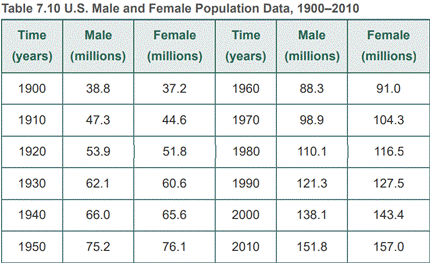
a.
To determine: The matrix of order 3 cross 2 that estimates the number of males and females in these three state.
The obtained matrix is
Given Information:
The table is defined,
| State | Population (millions) |
| California | 37.3 |
| Florida | 18.8 |
| Rhode Island | 1.1 |
Calculation:
Consider the given table,
| State | Population (millions) |
| California | 37.3 |
| Florida | 18.8 |
| Rhode Island | 1.1 |
Now, refer Table 7.10 U.S. Male and Female Population Data, 1900−2010 to find the population.

Now, use the ratio of male to female in the year 2010 as it is given
First, find for the California.
And,
Find for the Florida.
And,
Find for the Rhode Island.
And,
Now, make the matrix of the given order.
Therefore, the obtained matrix is
b.
To determine: The 3 cross 2 matrix form the given table.
The obtained result is
Given Information:
The table is defined,
| State | %Pop. Under 18 years | %Pop. 65 Years or older |
| California | 25.0 | 11.4 |
| Florida | 21.3 | 17.3 |
| Rhode Island | 22.3 | 14.3 |
Calculation:
Consider the given table,
| State | %Pop. Under 18 years | %Pop. 65 Years or older |
| California | 25.0 | 11.4 |
| Florida | 21.3 | 17.3 |
| Rhode Island | 22.3 | 14.3 |
From the given table the required matrix is defined as,
Hence, the obtained matrix is
c.
To calculate: The multiplication of the matrix in part (b) with the scaler.
The obtained matrix is
Given Information:
The given scaler for multiplication is
Calculation:
Consider the given table,
Refer the matrix from part (b).
Multiply the matrix by
Hence, the obtained matrix is
d.
To calculate: The matrix multiplication of the transpose of part (c) and part (a).
The total population of males and females that are under 18 years and 65 years or older for the three states
Given Information:
Refer the matrix form part (a) and part (c).
Calculation:
Consider the given information,
Find the transpose the matrix part (a).
Now, find the multiplication.
Which is indicating the total population of males and females that are under 18 years and 65 years or older for the three states.
Therefore, the obtained matrix is
e.
To calculate: The number of males under the age 18 lived in these three states in the year 2010 and number of females age 65 or older lived these three states.
The number of males under the age 18 is
Given Information:
Refer the matrix obtained from the part (b).
Calculation:
Consider the given information,
The first entry of the above matrix is representing the number males under age 18, that is
Therefore, the number of males under the age 18 is
Chapter 7 Solutions
PRECALCULUS:GRAPHICAL,...-NASTA ED.
 Calculus: Early TranscendentalsCalculusISBN:9781285741550Author:James StewartPublisher:Cengage Learning
Calculus: Early TranscendentalsCalculusISBN:9781285741550Author:James StewartPublisher:Cengage Learning Thomas' Calculus (14th Edition)CalculusISBN:9780134438986Author:Joel R. Hass, Christopher E. Heil, Maurice D. WeirPublisher:PEARSON
Thomas' Calculus (14th Edition)CalculusISBN:9780134438986Author:Joel R. Hass, Christopher E. Heil, Maurice D. WeirPublisher:PEARSON Calculus: Early Transcendentals (3rd Edition)CalculusISBN:9780134763644Author:William L. Briggs, Lyle Cochran, Bernard Gillett, Eric SchulzPublisher:PEARSON
Calculus: Early Transcendentals (3rd Edition)CalculusISBN:9780134763644Author:William L. Briggs, Lyle Cochran, Bernard Gillett, Eric SchulzPublisher:PEARSON Calculus: Early TranscendentalsCalculusISBN:9781319050740Author:Jon Rogawski, Colin Adams, Robert FranzosaPublisher:W. H. Freeman
Calculus: Early TranscendentalsCalculusISBN:9781319050740Author:Jon Rogawski, Colin Adams, Robert FranzosaPublisher:W. H. Freeman
 Calculus: Early Transcendental FunctionsCalculusISBN:9781337552516Author:Ron Larson, Bruce H. EdwardsPublisher:Cengage Learning
Calculus: Early Transcendental FunctionsCalculusISBN:9781337552516Author:Ron Larson, Bruce H. EdwardsPublisher:Cengage Learning





